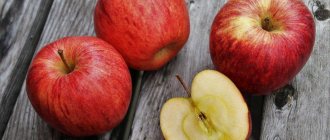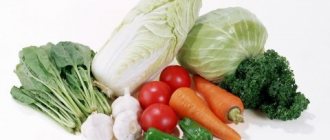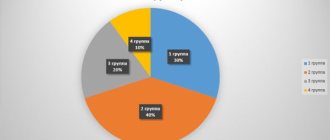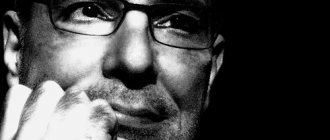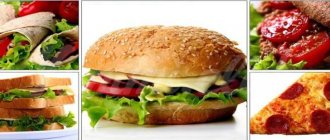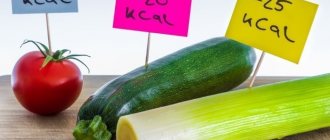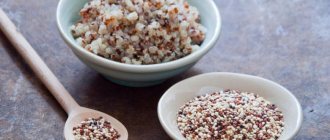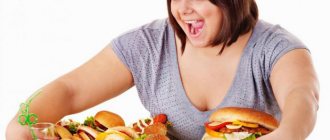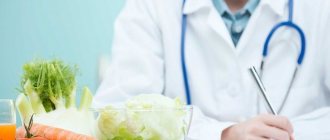Today, processed foods contain a lot of carbohydrates and animal fats. They also have a high glycemic index (GI). As a result of their consumption, blood sugar levels rise sharply. That is why it is important for a diabetic patient to know which foods increase blood sugar.
All about the glycemic index
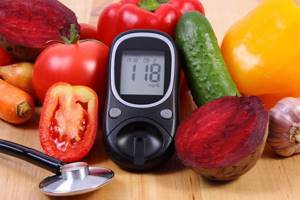
The glycemic index (GI) is a symbol for the rate at which carbohydrates contained in food are digested and increase blood sugar levels. The higher this indicator (more than 100), the faster glucose enters the biological fluid and the sharper the jump in its level will be. This important indicator should be taken into account by people with diabetes. The glycemic index is affected by:
- the amount of sugar and starch in products;
- method of preparing the dish (type of processing);
- degree of grinding of products (thoroughness of chewing).
For example, in boiled potatoes the GI will be 65, and in mashed potatoes it will rise to 90. The longer the food is processed, the higher the glycemic index. Consumption of such products provokes a sharp jump in blood glucose. To compensate for this pathological process, the pancreas begins to produce insulin. If you constantly abuse sugar-containing foods, a large amount of this hormone is produced, which begins to transport glucose into the cells. At some point they simply stop identifying insulin. This is how resistance to it appears. Diabetes mellitus develops over time.
Interesting! The GI theory was created in the 1980s specifically for diabetics. Now it is widely used for active weight loss and in proper nutrition.
Glycemic load is a dietary parameter of food that evaluates the quantitative effect of carbohydrates on blood sugar levels. It is calculated using the following formula: GI/100 (the amount of carbohydrates in a specific serving). It is believed that the ideal glycemic load would be 10-20 units.
Eating something that doesn't raise your blood sugar

The following is a list of foods with the lowest GI (not exceeding 40 units). This food can be safely included in the diet for diabetes, since it does not cause a sharp increase in blood glucose:
- lentils, beans, chickpeas;
- tomato juice, beets and fresh tomatoes;
- beans (golden and green);
- carrots, chickpeas;
- green peas (fresh);
- white cabbage, celery, broccoli;
- artichoke and eggplant;
- blackberries, strawberries;
- blueberries, blueberries;
- pomegranate;
- pear, apple;
- orange;
- dried apricots, apricots, prunes;
- cherry;
- garlic, sesame, bay leaf;
- mustard;
- dried tomatoes;
- basil, pumpkin seeds, ginger;
- almonds and cashews;
- parsley, oregano;
- cinnamon, soy sauce;
- black (wild) rice and Chinese noodles;
- buckwheat;
- soy flour;
- fructose ice cream;
- dark dark chocolate;
- jam and sugar-free peanut butter.
Rules of diet therapy
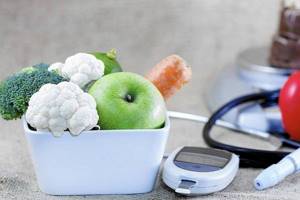
The intake of fast carbohydrates and fats into the body are the main causes of diabetes. Therefore, at any stage of the pathology you need to adhere to a special diet. Losing weight is contraindicated through a strict diet or fasting. Patients with diabetes should adhere to the following general principles:
- each serving should not exceed 200 g;
- food intake is increased to 5-6 times a day;
- reduce the total calorie intake;
- drink at least 2.5 liters of water per day;
- significantly reduce the consumption of sugar and salt, vegetable fats;
- It is better to bake, boil or steam dishes.
The main measure of nutrition is the bread unit, or carbohydrate unit (XU), an indicator of the carbohydrate content in foods. The menu for diabetics should be prepared by a specialist. It takes into account the severity of the condition, the patient’s age and lifestyle, and the presence of chronic pathologies.
Catering
The diet for diabetes is built taking into account several rules. The main thing among them is the exclusion of foods that increase glucose concentrations. This rule applies to both patients with mild manifestations of diabetes and patients with severe forms.
Calorie content of a sliced loaf: how harmful are sandwiches?
Meals should be moderate and regular. It is beneficial to eat at the same time of day every day, as this promotes better digestion and absorption of nutrients. It is recommended to consume most of the daily calorie intake before 17.00.
In addition to sugar-containing foods, fried, smoked, and fatty foods are excluded from the diet. It is not recommended to overuse canned food and sausages. All types of alcohol, carbonated drinks, and fast food are prohibited.
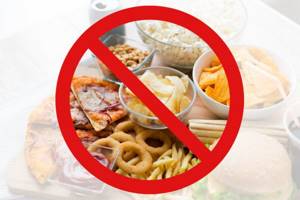
The daily calorie intake is from 2000 to 2500 kcal. Indicators vary depending on the individual needs of the body. The volume of water consumed (not taking into account other permitted drinks) is 1.5 liters or more.
It is recommended to prepare food by boiling, stewing, and baking. Such methods allow you to reduce sugar levels due to the natural process of destruction of carbohydrates under the influence of a thermal factor. Cooking with fish and meat broths is allowed.
Despite the wide range of restrictions, a diabetic's diet can be varied and tasty.
It is important that the prepared food has a pleasant appearance and arouses appetite. This allows you to reduce the stress load associated with eliminating habitual dishes, and prevents breakdowns and violations of the regime.
In general, nutrition for diabetes is carried out in compliance with a number of principles, the main of which is the exclusion of sources of sugar from the diet.
List of foods that raise blood sugar
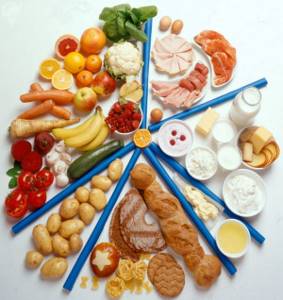
To correctly create a daily diet for people with diabetes, you should know which foods increase blood glucose levels. Foods that can raise your sugar levels are presented in the table.
| GI level | Product Name |
| 146-100 | Butter products, white bread, pancakes, dates, watermelon, rice noodles, canned apricots, vermicelli |
| 99-90 | Baked potatoes, honey, instant cereals, pasta, milk rice porridge, buns, beets |
| 89-80 | Mashed potatoes, corn flakes, boiled carrots, muesli with raisins and nuts, ice cream, beans |
| 79-70 | Melon, pumpkin, rice porridge, millet, any chocolate, semolina, pineapple, white rice, millet, barley, black yeast bread, sweet carbonated drinks |
The table may be useful not only for diabetics, but also for women who have been diagnosed with the gestational form of the disease - a special type of diabetes that develops in pregnant women against the background of hormonal changes. This data is also needed by people who are prone to diabetes.
You need to be careful when choosing fruits. It is strictly forbidden to eat fruits that contain large amounts of sugar. For example, grapes, bananas. Allowed:
- citrus;
- plum;
- pears;
- apples;
- pomegranate;
- gooseberry;
- kiwi, etc.
Experts recommend consuming fruits both fresh and frozen. They contain a large amount of vitamins, pectin and fiber. All these components have a beneficial effect on the condition of the body. The functioning of the gastrointestinal tract improves, toxins are eliminated, cholesterol and blood sugar levels are reduced.
What to eat and what not to eat
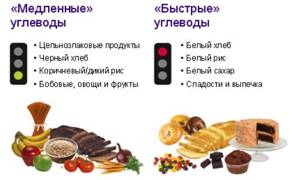
It is best to eat foods that have been prepared in natural conditions. However, due to the rapid development of chemical products today, this seems unlikely. You should also eat food that is inherently hypocaloric, high in fiber and dietary fiber, and as balanced in composition as possible.
It is recommended to listen to your body and pay attention to the feeling of fullness and hunger. Remember that the satiety center does not always work immediately; it often gives signals 15-20 minutes after the start of eating.
Read also: Can you eat melon if you have type 2 diabetes?
Authorized Products
Products that quickly cope with hunger, as well as those that are as balanced as possible in their composition, include:
- lean meat;
- fish, other seafood;
- hard cheeses;
- olives, black olives;
- vegetables - tomatoes, cucumbers, zucchini, eggplant, onions and others;
- avocado;
- olive, butter and coconut oil, dairy products (cottage cheese, sour cream, cream).
Products can be consumed with restrictions
Foods that should be limited for various reasons:
- sweet fruits and berries;
- yoghurts;
- any chocolate, both milk and dark;
- wine;
- alcoholic drinks - can greatly influence glycemia, both raising it and lowering it;
- nuts.
When limiting the carbohydrate load, insulin production always decreases, which leads to the removal of salt deposits and water reserves from the body. In this case, it is necessary to compensate for these losses by consuming salt. However, if you have concomitant pathologies of the cardiovascular system, before adding salt to your diet, you need to be examined by a cardiologist to find out whether this can be done and in what quantities.
What you shouldn't eat

The foods that have the greatest impact on blood sugar contain a lot of carbohydrates, so diabetics should exclude them from their diet as much as possible:
- flour;
- corn;
- cereals;
- potato;
- peas, beans and other legumes;
- fruits;
- milk and sweet dairy products;
- confectionery;
- carbonated drinks;
- sugar;
- beer.
Effect of nutrients on glycemia
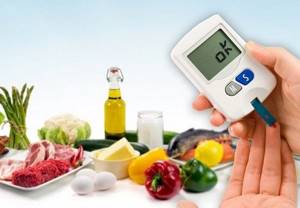
Every day the human body enters food that contains a certain amount of fats, proteins and carbohydrates, i.e. nutrients. They all have different effects on blood glucose levels. Effect of nutrients on glycemia:
- Fast carbohydrates are carbohydrates that are easily processed by the body. They have a glycemic index above 50. They very quickly contribute to an increase in glucose in biological fluid. Their abuse leads to obesity. Therefore, all healthy nutrition systems recommend limiting the consumption of such foods. Sausages, honey, flour products, starch, potatoes, sweets, fast food, white bread are products related to fast carbohydrates.
- Slow carbohydrates are carbohydrates with a low GI (less than 50). These primarily include cereals, coarse grains and some foods containing starch - beans, lentils, as well as vegetables and most fruits that are rich in fiber, which is very beneficial for the body. Slow carbohydrates gradually release glucose, energy is consumed over a long period of time. A sharp jump in insulin is not required for its absorption. Therefore, the absorbed glucose is distributed gradually, without turning into fat.
- Proteins are processed by the body very slowly. Glucose is the last to be released. Products that contain large amounts of protein increase blood sugar slightly. Therefore, diabetics are allowed to include lean meats and fish, nuts, and mushrooms in their diet.
- Fats are detrimental to the health of diabetics. They can provoke a sharp jump in blood sugar levels and significant weight gain. If you have diabetes, exclude any fatty meat, sausages, and fatty sauces. In addition, fats contain bad cholesterol, which is deposited on the vascular walls in the form of plaques.
Diabetes mellitus is not a contraindication to the consumption of milk and dairy products. However, there are some restrictions on the use of these products. It is forbidden to drink fresh milk, which can cause a sharp jump in blood glucose. Particular attention is paid to the fat content of dairy products. Patients are allowed to consume whey, yogurt, and the “Milk Mushroom” drink.
Interesting! Condensed milk is a product that increases blood sugar because... its glycemic index is 80 units.
Sour cream and cream are excluded from a diabetic's diet. This is due to the high content of milk fat and the total calorie content of the products. Per 100 g of sour cream (20%) there are 206 kcal and 3.2 carbohydrates. And 100 g of cream contains 212 kcal. Cottage cheese is also capable of triggering the production of insulin, which is due to its high GI.
Cereals
Most cereals are included in the approved list of foods for diabetics. They have an average glycemic index, sufficient energy value and a rich chemical composition. Healthy cereals include millet, wheat, unpolished oats, buckwheat, and bulgur. The complex carbohydrates in their composition are broken down gradually, so after consuming them, the level of glucose in the bloodstream rises slowly.
Among the cereals that negatively affect the diabetic body are semolina and white rice. Dishes prepared from them are high in calories, contain a lot of fast carbohydrates, and if consumed frequently, provoke obesity. They contain practically no biologically valuable substances; they simply saturate the body with “empty” calories, and this is extremely undesirable for diabetes.
Any porridge (even from the list of allowed cereals) cooked with milk also increases sugar levels. Sugar and honey should also not be added to such dishes, as they increase the glycemic index of the porridge and increase the load on the pancreas.
Foods that normalize blood sugar

To prevent diabetes and control blood sugar levels, you should regularly eat the following foods:
- oatmeal;
- nuts and dried fruits;
- Jerusalem artichoke;
- avocado;
- cinnamon, ginger;
- millet, buckwheat;
- citrus;
- cherry;
- leafy greens;
- red bell pepper;
- green vegetables;
- onion garlic;
- seaweed;
- seafood (lean fish, shrimp, squid, mussels);
- broccoli.
Flaxseed oil is a valuable product that is used both to maintain normal blood sugar concentrations, prevent diabetes, and to treat the disease. The product is easily digestible, so it is very useful for people with fat metabolism disorders. In addition, the oil is rich in polyunsaturated fatty acids. For diabetes, it is recommended to drink green tea, mineral water, and freshly squeezed juices. You are allowed to drink a glass of wine once a week.
It is very difficult to create a correct diet on your own if you have high blood glucose, because... there are many nuances to consider. Therefore, it is better to entrust menu selection to a specialist. The bulk of the daily diet of patients with diabetes should consist of fresh vegetables, herbs and sour fruits. It is better to limit the amount of sugar-containing products.
Fruits for diabetes
Sweet fruits with a high GI can raise sugar, so they should be consumed in minimal quantities. Juicy sweet fruits help increase glycemia. However, sour fruits can also contain a lot of monosaccharides, as they contain substances that mask the sweetness.
List of fruits beneficial for diabetes:
- lemon;
- unsweetened apples;
- grapefruit;
- orange;
- sweet and sour tangerines;
- apricot;
- cherry plum;
- peaches;
- pears;
- avocado;
- passion fruit;
- plums;
- cherry;
- pomegranate;
- nectarine;
- kiwi.

Fruits for diabetes
These fruits stabilize sugar levels, increase immunity, saturate the body with vitamins and microelements, and improve metabolism. It is worth paying attention to the fiber content. The more it is in fruits, the slower the sugars are absorbed. Prominent representatives of such fruits are peaches, pears and apples.
Advice! Eating 3-4 blue plums or one kiwi daily helps reduce sugar.
It is important not to sprinkle sugar on the fruit. Diabetics are recommended to consume frozen fruits. Freshly squeezed juices can sometimes diversify the menu. But it is worth considering that in this form glucose will be absorbed faster.
High GI fruits are not recommended to be included in the diet. These include:
- dates;
- raisin;
- grape;
- bananas;
- melon;
- mango;
- persimmon;
- watermelon.
In addition to fruits, it is useful for diabetics to eat berries: black and red currants, strawberries, blackberries, raspberries, blueberries. If you have high sugar levels, it is recommended to eat lingonberries. The berry has anti-inflammatory, antimicrobial and antipyretic effects. In diabetes, lingonberries are recommended to reduce hyperglycemia, as well as treat concomitant pathologies: atherosclerosis, hypertension, urolithiasis.
